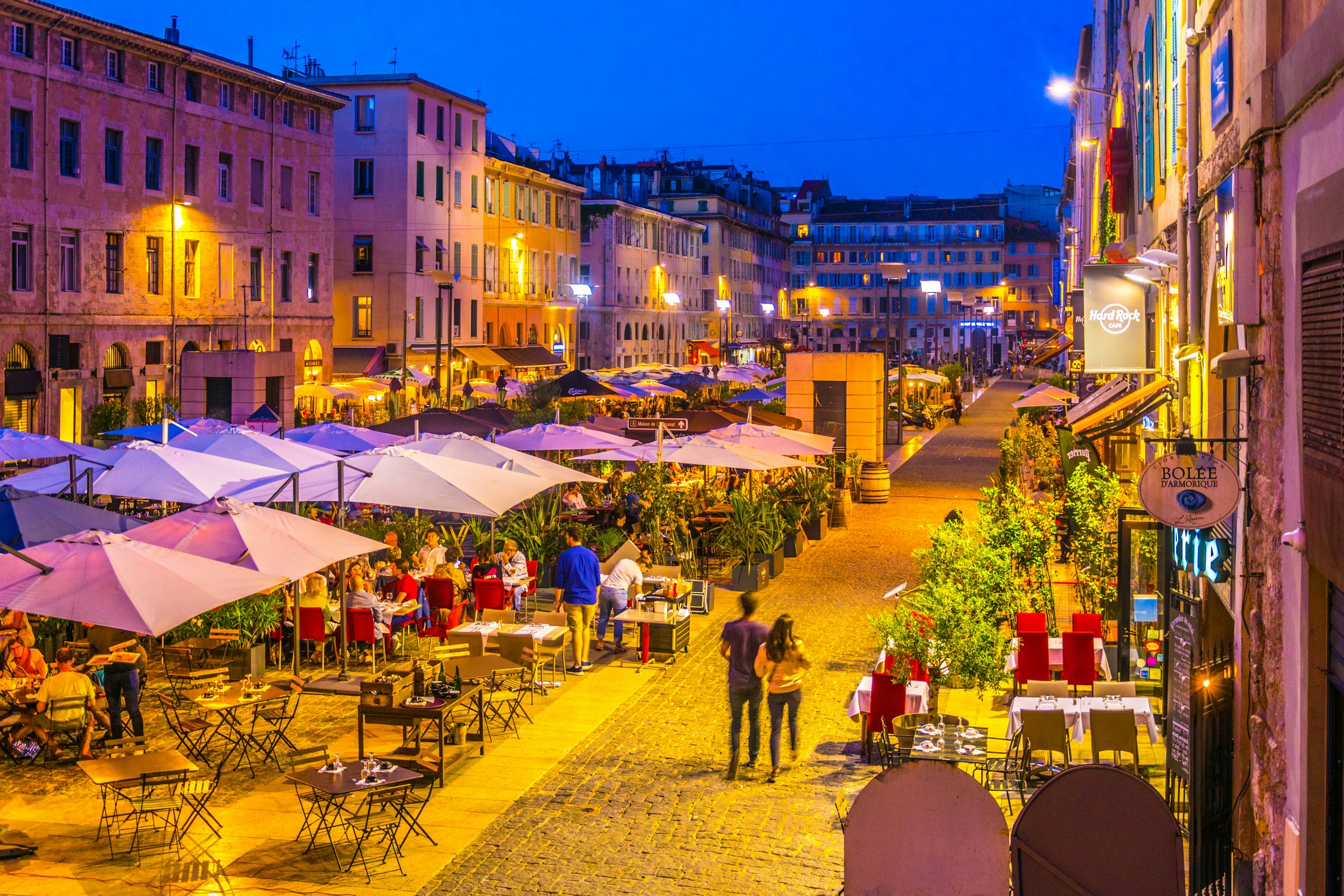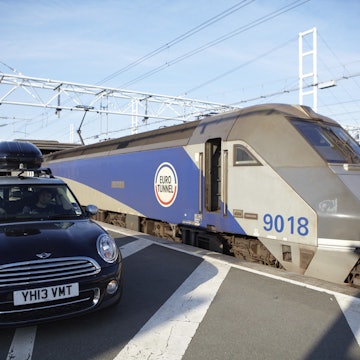

Cycling around Marseille, France is great in the summer. Anton Havelaar/Shutterstock
Marseille’s reputation as a frenetic port city in southern France precedes it and navigating its noisy, traffic-clogged streets can be exhausting. But the revitalizing Mediterranean Sea is never far away and with some savvy planning, getting around can be a breeze.
Don’t even consider driving. The combo of undisciplined motorists, pesky scooters slaloming between congested traffic lanes and hellish parking makes motoring in Marseille an experience best avoided.
Despite its size – this is France’s second-largest city – the city center is compact and can be navigated on foot. An efficient network of city buses, boats, trams and a two-line metro makes light work of accessing further flung parts of the city, including its long stretch of beaches and offshore islands. In summer, bike or boat are the best way to get around – the metro is stifling. Year-round, visitors with a Marseille City Pass (€32/43/52 for 24/48/72h) have unlimited access to public transport, including shared bikes.

Bus it from the airport into town
St-Charles is the main transport hub, with high-speed trains, regional and urban buses and both metro lines converging at mainline train station Gare St-Charles, gare routière (bus station) and public-transport hub Pôle d’Echange Multimodal (PEM). Shuttle buses from Marseille-Provence airport arrive here every 10 to 15 minutes; count 25 minutes from the airport into town.
Trams and buses run by public transport company RTM use the same tickets as the metro. Buy tickets from machines at tram stops and on buses, or at ticket desks inside Gare St-Charles and at the Espace Infos RTM on rue des Fabres. Bus drivers sell tickets but they are pricier – €2 instead of €1.70 for a single journey.
Electric buses only serve a couple of lines, but the city aims to have the entire network electric by 2035.
To cross the city quick, take the metro
Marseille has two metro lines (M1 and M2), with 30 stations covering the city. Metro line M1 links the St-Charles train station with the Vieux Port. Line M2 is handy for getting from train station to MuCEM and Fort St-Jean in the waterfront Joliette area (Joliette stop), trendy Cours Julien (Notre-Dame du Mont stop) and the Prado beaches (Rond-Point du Prado stop).
A single ticket/carnet of 10 costs €1.70/15, plus an initial €0.10 for the rechargeable card. If you intend to use the metro several times, a 24hr ticket (€5.20) is good value. Trains run 5am to 12:30am daily. Avoid using the trains alone late at night; otherwise, the metro in Marseille is as safe as any other big city.
Most metro stations require a hike up/down steps. Those in wheelchairs, with pushchairs or young tots can plot the best route on the RTM website or mobile app. Both also locate staircases and ascenseurs (elevators), and indicate if elevators are “en panne” (broken) or “en entretien” (undergoing maintenance work).
Set sail across the port or to an island
Explore France’s oldest port and largest cruise hub afloat. At the Vieux Port the vintage cross-port Ferry Boat that yo-yos across the water from the town hall on quai du Port (north) to place aux Huiles (south) is the world’s shortest ferry ride. The toylike boat – operated by RTM – takes less than five minutes to cover the distance (238m) across the port. Tickets are a snip at €0.50.
Seasonal RTM navettes maritimes (shuttle boats) sail from the Vieux Port to the northern suburb of L’Estaque and La Pointe Rouge, known for its beaches and rocky coves. Boats continue to the fishing village of Les Goudes, popular with families on summer weekends. A scenic voyage aboard the Frioul Express to Château d’If and the rocky Îles de Frioul is a Marseillais rite of passage.

Rent a bike or e-bike to pedal to the beach
Cycling in downtown Marseille is a nerve-racking experience – the city is one of France’s least bike-friendly. But two wheels are convenient for cruising south to the Prado beaches or escaping the city heat on an exhilarating day trip to Les Calanques or elsewhere along the coast.
Plenty of outlets in town rent bicycles. For e-bikes, pick up a shared Lime e-bike from a free-floating station or try Fada Bike; the latter runs fantastic themed guided tours.
There is a dedicated, two-way cycling lane winding 2km along Corniche Président John F Kennedy that is part of the 130km of lanes planned for the city by 2030. Keep tabs on new lanes and pinpoint the best route in real time from A to B with the excellent navigation app, Géovélo.
For coastal views, scoot along the seafront
Cruise along the wide, coastal sweep of La Corniche by trottinette électrique. These lightweight electric scooters reach speeds of 25km/h and are handy for covering longer distances in the city. They can be carried on buses and the metro, allowing you to mix and match public transport. Pick up wheels from one of the public e-scooter stations operated by Lime or Voi; reserve and pay minutes in advance via the phone app or station terminal.

Explore on foot to find cinematic backdrops and forgotten neighborhoods
From Jean-Luc Godard’s iconic 1960s movie À Bout de Souffle (Breathless) to contemporary box-office hits like Luc Besson’s Taxi (1998) or Stillwater (2019) starring Matt Damon, movie makers have always adored salt-of-the-earth Marseille. Walking is hands down the best way to explore this animated film set of a port city.
Marseille is divided into 16 arrondissements but, as every Marseillais will tell you, the city has 111 quartiers or villages. Walking tours organized by the tourist office lead the curious away from tourist-loved Le Panier or Vieux Port into intriguing neighborhoods such as La Treille, Chutes-Lavie and St-Jean du Désert. Walking also creates a precious opportunity to delve into green Marseille. City parks promise hours of scenic promenading.
Accessible transportation in Marseille
Marseille’s public transport system is challenging to navigate for travelers with disabilities. Accessible bus stops served by ramp-equipped buses are indicated on public transport maps, online and in the RTM app; accessible stops can be in one direction only so check route maps carefully. All trams have ramps and waist-high buttons inside to signal you want to get off at the next stop. A €200 million accessibility makeover of 13 metro stations was completed in recent years.
Walking in Marseille plunges you into action
No other French city is so electrifying with its sensorial mashup of sounds, sights, smells – of fish, flowers, ship fuel at the port, the sea, spices at the market, bouillabaisse slowly cooking on the stove – and walking plunges you into the heart of this action. It can be messy and frequently maddening, but walking to the end of every street can uncover unexpected sights and spontaneous experiences you could never plan or consciously engineer. My favorite guided walking tour? The tourist office’s biodiversity-themed “Balade Buissonnière” around “wild Marseille”: think clandestine green spaces, secret walled gardens, hills, dunes and other flora-rich, natural heritage spots.
















